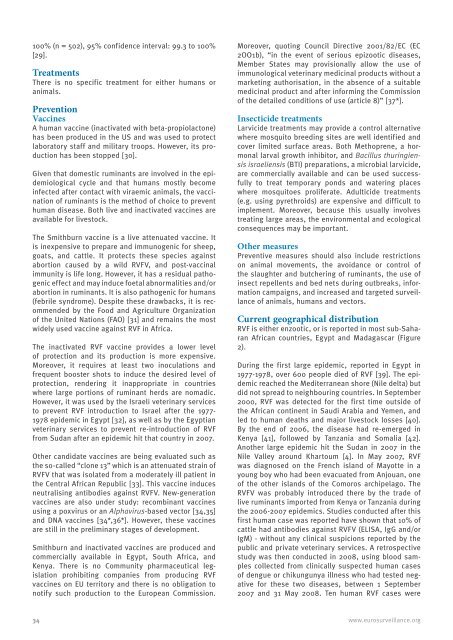Vector-borne diseases - Eurosurveillance
Vector-borne diseases - Eurosurveillance
Vector-borne diseases - Eurosurveillance
Create successful ePaper yourself
Turn your PDF publications into a flip-book with our unique Google optimized e-Paper software.
100% (n = 502), 95% confidence interval: 99.3 to 100%<br />
[29].<br />
Treatments<br />
There is no specific treatment for either humans or<br />
animals.<br />
Prevention<br />
Vaccines<br />
A human vaccine (inactivated with beta-propiolactone)<br />
has been produced in the US and was used to protect<br />
laboratory staff and military troops. However, its production<br />
has been stopped [30].<br />
Given that domestic ruminants are involved in the epidemiological<br />
cycle and that humans mostly become<br />
infected after contact with viraemic animals, the vaccination<br />
of ruminants is the method of choice to prevent<br />
human disease. Both live and inactivated vaccines are<br />
available for livestock.<br />
The Smithburn vaccine is a live attenuated vaccine. It<br />
is inexpensive to prepare and immunogenic for sheep,<br />
goats, and cattle. It protects these species against<br />
abortion caused by a wild RVFV, and post-vaccinal<br />
immunity is life long. However, it has a residual pathogenic<br />
effect and may induce foetal abnormalities and/or<br />
abortion in ruminants. It is also pathogenic for humans<br />
(febrile syndrome). Despite these drawbacks, it is recommended<br />
by the Food and Agriculture Organization<br />
of the United Nations (FAO) [31] and remains the most<br />
widely used vaccine against RVF in Africa.<br />
The inactivated RVF vaccine provides a lower level<br />
of protection and its production is more expensive.<br />
Moreover, it requires at least two inoculations and<br />
frequent booster shots to induce the desired level of<br />
protection, rendering it inappropriate in countries<br />
where large portions of ruminant herds are nomadic.<br />
However, it was used by the Israeli veterinary services<br />
to prevent RVF introduction to Israel after the 1977-<br />
1978 epidemic in Egypt [32], as well as by the Egyptian<br />
veterinary services to prevent re-introduction of RVF<br />
from Sudan after an epidemic hit that country in 2007.<br />
Other candidate vaccines are being evaluated such as<br />
the so-called “clone 13” which is an attenuated strain of<br />
RVFV that was isolated from a moderately ill patient in<br />
the Central African Republic [33]. This vaccine induces<br />
neutralising antibodies against RVFV. New-generation<br />
vaccines are also under study: recombinant vaccines<br />
using a poxvirus or an Alphavirus-based vector [34,35]<br />
and DNA vaccines [34*,36*]. However, these vaccines<br />
are still in the preliminary stages of development.<br />
Smithburn and inactivated vaccines are produced and<br />
commercially available in Egypt, South Africa, and<br />
Kenya. There is no Community pharmaceutical legislation<br />
prohibiting companies from producing RVF<br />
vaccines on EU territory and there is no obligation to<br />
notify such production to the European Commission.<br />
Moreover, quoting Council Directive 2001/82/EC (EC<br />
2OO1b), “in the event of serious epizootic <strong>diseases</strong>,<br />
Member States may provisionally allow the use of<br />
immunological veterinary medicinal products without a<br />
marketing authorisation, in the absence of a suitable<br />
medicinal product and after informing the Commission<br />
of the detailed conditions of use (article 8)” [37*].<br />
Insecticide treatments<br />
Larvicide treatments may provide a control alternative<br />
where mosquito breeding sites are well identified and<br />
cover limited surface areas. Both Methoprene, a hormonal<br />
larval growth inhibitor, and Bacillus thuringiensis<br />
israeliensis (BTI) preparations, a microbial larvicide,<br />
are commercially available and can be used successfully<br />
to treat temporary ponds and watering places<br />
where mosquitoes proliferate. Adulticide treatments<br />
(e.g. using pyrethroids) are expensive and difficult to<br />
implement. Moreover, because this usually involves<br />
treating large areas, the environmental and ecological<br />
consequences may be important.<br />
Other measures<br />
Preventive measures should also include restrictions<br />
on animal movements, the avoidance or control of<br />
the slaughter and butchering of ruminants, the use of<br />
insect repellents and bed nets during outbreaks, information<br />
campaigns, and increased and targeted surveillance<br />
of animals, humans and vectors.<br />
Current geographical distribution<br />
RVF is either enzootic, or is reported in most sub-Saharan<br />
African countries, Egypt and Madagascar (Figure<br />
2).<br />
During the first large epidemic, reported in Egypt in<br />
1977-1978, over 600 people died of RVF [39]. The epidemic<br />
reached the Mediterranean shore (Nile delta) but<br />
did not spread to neighbouring countries. In September<br />
2000, RVF was detected for the first time outside of<br />
the African continent in Saudi Arabia and Yemen, and<br />
led to human deaths and major livestock losses [40].<br />
By the end of 2006, the disease had re-emerged in<br />
Kenya [41], followed by Tanzania and Somalia [42].<br />
Another large epidemic hit the Sudan in 2007 in the<br />
Nile Valley around Khartoum [4]. In May 2007, RVF<br />
was diagnosed on the French island of Mayotte in a<br />
young boy who had been evacuated from Anjouan, one<br />
of the other islands of the Comoros archipelago. The<br />
RVFV was probably introduced there by the trade of<br />
live ruminants imported from Kenya or Tanzania during<br />
the 2006-2007 epidemics. Studies conducted after this<br />
first human case was reported have shown that 10% of<br />
cattle had antibodies against RVFV (ELISA, IgG and/or<br />
IgM) - without any clinical suspicions reported by the<br />
public and private veterinary services. A retrospective<br />
study was then conducted in 2008, using blood samples<br />
collected from clinically suspected human cases<br />
of dengue or chikungunya illness who had tested negative<br />
for these two <strong>diseases</strong>, between 1 September<br />
2007 and 31 May 2008. Ten human RVF cases were<br />
34 www.eurosurveillance.org

















